 |
Fort Mont Louis
Mont-Louis, Pyrénées-Orientales, France
|
|
 |
Constructed: 1679-1689
Used by: France, Spain
Conflicts in which it participated:
None
|
There are a lot of starforts in the Pyrenees Mountains, which define much of the border betwixt France and Spain. None, perhaps, were as significant as the highest fortified village in France, designed by Vauban, and named for the Sun King himself.
Twas Sun King Louis XIV (1643-1715) who directed the Father of the Starfort, Vauban (1633-1707), to head to the Pyrenees in 1679, to search for mountain peaks atop which to work his magic. |
 |
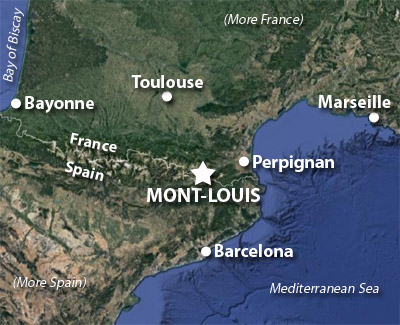 |
|
Signed in November of 1659, the Treaty of the Pyrenees ended the Franco-Spanish War of 1635-1659. This was a "largely inconclusive" conflict, but one thing it did have going for it was a spectacular battle that involved the stellar starfort of Rocroi, which took place in May of 1643. As part of the treaty that ended the war, France gained some territory in the Pyrenees along its southwest border with Spain...and what you definitely wanted defining your border with a pugnacious neighbor in the 17th century, absent a big, wide river full of cross-bred alligator/piranhas, were mountains. This being the golden age of defensive fortification, Vauban was, as aforementioned, dispatched. |
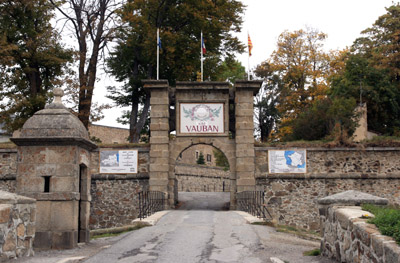 Fort Mont Louis' main gate. The French are justly proud of Vauban's world-class starfortery, holding him in as high regard as Americans generally feel about someone like...Thomas Edison (1847-1941), perhaps? Fort Mont Louis' main gate. The French are justly proud of Vauban's world-class starfortery, holding him in as high regard as Americans generally feel about someone like...Thomas Edison (1847-1941), perhaps? |
 |
The Starfort Man, as usual, selected the perfect spot. A mountaintop overlooking the Tet River, commanding the road from Toulouse to Perpignan, whose enticing peak was split in three levels: The highest was to be adorned with the expected square, four-bastioned citadel, below which would be the Ville, or upper town, and below that would be the Ville basse, or lower town, with three more bastions. Clearly it was Vauban's job to envision and design the best fortification possible, without regard to cost...because on several occasions his initial designs were reworked so as to be realized more cheaply. In this case, the men who made Vauban's vision a reality decided that just the upper town would be sufficient. |
|
|
Why all these additional towns, upper and/or lower? Because when one builds one's fort in the middle of noplace, one needs to arrange for a population to support its garrison! One of the reasons Vauban chose the location for this, Mont-Louis, was due to its proximity to the hamlet of Vilar d'Ovança, which would theoretically be able to contribute labor, stone, wood and foodstuffs to the starfort-building effort...but a fort that relies on a separate community for support wouldn't fare well in a siege situation, so an enclosed, self-supporting population was optimal.
|
Vauban sent his plans to the authorities in Paris in May of 1679, and one can't imagine those authorities doing much other than flashing a grin and an immediate thumbs-up whenever Vauban submitted things to them. Work commenced soon thereafter, with French soldiers doing most of the labor, seeing as this took place during a brief period in which France, inexplicably and probably uncomfortably, wasn't actively fighting anybody.
By 1680 there were 3,700 soldiers beavering away on Fort Mont-Louis, overseen by specialized craftsmen such as blacksmiths, masons, carpenters and so forth. This workforce was not a particularly happy one, as conditions were harsh, and soldiers historically put on a uniform with the intention of fighting and/or looking cool to the ladies...neither of which goal is achieved by dragging giant blocks of granite up the Godforsaken Pyrenees. Desertion was a frequent occurrence, but our starfort somehow managed to get built anyway, and by October of 1681 the citadel was complete enough to be manned in an expectation of being able to defend itself.
All of 29 months had passed since Vauban's first visit to Mont-Louis, and here we were with a "completed" citadel! That's a pretty brief period of time in which to build a major starfort, particularly with less-than-fully-committed laborers. The result was a fort with poor-quality masonry, which had to be repeatedly repaired through the 18th century.
Fort Mont-Louis' citadel and enclosed town area were both completed ten years after ground was broken. The citadel would eventually have accommodations to house up to 2,500 soldiers and 300 horses, but filling the town proved more difficult. "Hey, potential townspersons, who wants to live on top of a mountain, far away from everything, at a place that we're pretty certain the Spanish will eventually attack? C'mon, who'll be the first to sign up? Anybody?" Nobody.
|
 |
|
|
The sort of bastioned outpost that Vauban envisioned for Mont-Louis was by no means unheard-of (it is one of nine such fortified cities that Vauban designed, six of which are in France), but they were understandably difficult to populate. A similar situation at Palmanova, a Venitian city built in the 1620's to serve as a bulwark against the wicked Turks at what is today the northeastern corner of Italy, found the Venitians being forced to pardon hundreds of prisoners and moving them to this most sought-after location, seeing as nobody chose to throw themselves patriotically into the path of the ever-marauding Ottomans. Plus, this sort of forward operating post brought with it a certain element of aggression aimed at those parties one might wish to deter...and while slamming a big spiky fortified thing down at the border made sense at times when tempers were running hot, once things cooled down that same good idea could seem like an unnecessary provocation. By 1694 this had indeed become the case, and none other than Vauban himself advocated for Fort Mont Louis to be demolished, and for the surrender of the entire Cerdanya region, which our fort had been built to defend. Fortunately for those of us who enjoy looking at old starforts, the Sun King didn't take this suggestion seriously.
|
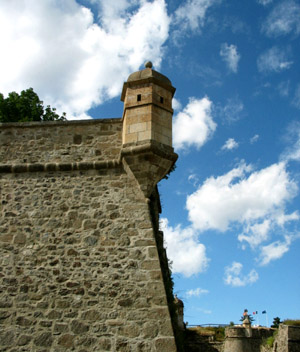 Vauban sure liked his multisided guérites, which are referred to in this case as bartizans. Is there a difference betwixt the two? I thought of the bartizan as the medieval forerunner to a starfort's guérite...but there is a distinct (though painful) possibility that I might not know everything. Vauban sure liked his multisided guérites, which are referred to in this case as bartizans. Is there a difference betwixt the two? I thought of the bartizan as the medieval forerunner to a starfort's guérite...but there is a distinct (though painful) possibility that I might not know everything. |
 |
The protected town of Mont-Louis grew at an especially petrified snail's pace. In the 1720's, only five of the town's fifty houses were occupied, but a church was finally constructed there in the 1730's. Not wishing all of this expenditure to go to waste, the surrounding communes (similar to states, or maybe counties) utilized the Mont-Louis complex as a prison, which surely made it an even more desirable destination for potential townspersonnel.
Whatever amalgamation of convicts, grudging townspeoples, sailors without a shipboard berth and soldiers populated Mont-Louis in January of 1793 got a special treat: The French Revolution, among its many societal upheavals, made it necessary to rename everything that had been named after royalty, feudalism and/or superstition, which is to say everything. Mont-Louis became Mont-Libre, which title remained in place until cooler (or more monarchial) heads prevailed in 1803, which is why we're calling it Mont-Louis today.
The other nations of Europe, monarchies all, were alarmed and displeased when the Revolutionary French executed their King Louis XVI (1754-1793). |
|
|
The National Convention, the new parliament that "ruled" France from 1792 to 1795, swiftly moved to mollify its neighbors by declaring war on them. This was seen as self-preservation, as the restoration of France's monarchy was to everyone's benefit (except France's), and particularly those meddlesome British would be coming after France soon enough. Let's just get it over with! War! War! War!
In addition to being the "highest fort in France" (at 1600 "meters," which is about 5250 feet), Fort Mont Louis also holds the dubious distinction of never having been besieged...wouldn't a starfort that had been unsuccessfully besieged be awesomer, in that it had proven its starfortidude? Whatever, our fort came its closest to conflict in August of 1793, during the War of the Pyrenees (1793-1795). Spain's army marched over the border and occupied Col de la Perche, just a couple miles southwest of Fort Mont Louis: Col de la Perche is a nice pass betwixt the otherwise-difficult-to-navigate Pyrenees, so nice that famed Carthaginian commander Hannibal (247-181BC) had utilized it during the Second Punic War (218-201BC), in order to take his army through the mountains in order to sneak past some Greek cities along the Mediterranean Sea. Back in the modern 18th century, the Spanish were ejected from the pass shortly after they got there, and Fort Mont Louis continued its sublime, peaceful existence.
|
This lil' offshoot warlet of the Napoleonic Wars that took place betwixt the French and Spanish in the Pyrenees ended in August of 1795, and Fort Mont Louis was utilized as a warehouse for the French Army of the Pyrenees-Orientales for the next several years.
As things progressed in the decades of war that began with the French Revolution (1789), our old friend Napoleon (1769-1821) installed his brother Joseph Bonaparte (1768-1844) first as the King of Naples and Sicily (1806), and then of Spain (1808). Joseph would have been more than happy to remain in Sicily, as the Sicilians actually liked him, whereas the Spaniards most definitely did not. Efforts to dislodge this Napoleonish King from the Spanish throne got underway more or less immediately.
|
 |
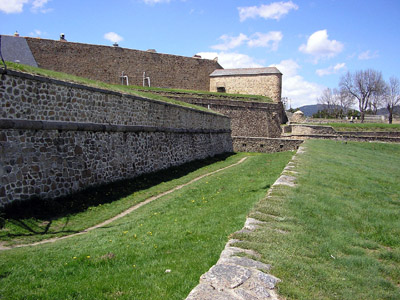 The moat, and where the Village's walls meet those of the fort, at what I will cautiously identify as Fort Mont Louis' southern bastion, which of course isn't called the southern bastion, but the Bastion de Roussillon. The moat, and where the Village's walls meet those of the fort, at what I will cautiously identify as Fort Mont Louis' southern bastion, which of course isn't called the southern bastion, but the Bastion de Roussillon. |
|
The Army of Spain, which upon first glance one would be excused for imagining was a Spanish organization - but which was just the portion of the French army that was dedicated to conquering Spain good 'n' proper - took up residence at Fort Mont Louis in 1808, from whence they swooped down into Spain on numerous occasions, punishing those fools who wished to not have someone named Bonaparte as their king. Fortunately Napoleon was finite, and was sent away to rot in 1815.
The well that Vauban had designed for Fort Mont Louis was 92 feet deep, with the water 43 feet below the surface. The cage à écureuil (squirrel cage) system by which water was brought to the top could only be worked by one person, and its operation was so unpleasant that it was nicknamed the "convict well," even though there were no convicts kept at our fort for such labor...fortunately some manner of piped water was brought to the citadel in 1830, and the garrison no longer had anything to complain about.
The Pyrenees remained the border betwixt France and Spain, and the Fort Mont Louis was maintained and kept ready for action...and 1887 brought with it a determination to drag Fort Mont Louis into the technologically advanced late-19th century.
Though our fort was and is, as I may have mentioned 15 or 16 times already, the highest in France, there were relatively nearby peaks that were higher, and it's disadvantageous to have undefended high ground overlooking your fort, lest an enemy place artillery atop it. It's unlikely that Vauban would have missed this fact, but the relatively short-ranged artillery of the late 17th century was a much different animal than that of the late 19th century, which was the reason upgrades needed to be made in this instance.
|
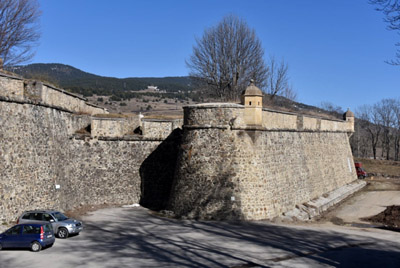 Peeking around the corner of one of Fort Mont Louis' bastions! Do I know which bastion? No, I'm afraid that I do not. Peeking around the corner of one of Fort Mont Louis' bastions! Do I know which bastion? No, I'm afraid that I do not. |
 |
Of course the reason for Fort Mont Louis' 1887 upgrade could have had to do with any number of events that transpired in that year: Zululand became a British colony, for instance, which may have been felt to threaten France's border with Spain. Also, construction of the Eiffel Tower got underway in Paris, and you know this must have caused the Spanish to boil with retributive jealousy.
Whatever the real reason for all of this activity, a "strategic path" called the Cannon Path connected two new gun positions on the nearby peaks of Tossa and Figuema to our fort. This path was likely just a standard covered way...low-tech, but way better than nothing. |
|
|
Fort Mont Louis housed refugees during the Spanish Civil War (1936-1939), and all of the late-19th-century modernization that had been poured atop the mountain of our interest didn't prevent the Germans from effortlessly occupying our fort (about as effortlessly as they occupied the rest of France) during the Second World War (1939-1945). Free French forces liberated the fort at the end of this conflict.
The end of the 20th century's second war to end all wars brought the opposite of peace to many of France's colonial holdings. Having had a taste of what freedom might be like when the French were forced to flee from their colonies during the war, neither French Indochina (Vietnam) nor Algeria cared to return to the fold of the empire Français glorieux, and troubles-a-plenty sprouted in Asia, Africa and France as a result of their independence movements.
A French paratrooper unit that became known as the 11th Shock Regiment took up residence at Fort Mont Louis in 1946. This elite unit was intended to be used for lightning strikes against potential coups, strikes or whathaveyou, and fought with fierce skill and élan in Indochina, Algeria and the Suez...but the fiercest élan in the world couldn't have retained France's empire. The 11th was disbanded in 1963, after a failed coup in which elements of the French military planned to sieze control of its own government, following the decision to abandon the effort to retain Algeria as a colony. No officers of the 11th actually participated in the planning of this coup, but it was suspected that they had sympathy for the coupers. Those interested in reading of the 11th's amazing exploits should check out David Lee Corley's Airmen Series books, which I can't recommend highly enough.
|
Every site that has information about Fort Mont Louis mentions its solar furnace, so it must be a big deal. In 1949 French engineer Félix Trombe (1906-1985) directed the construction of a 50kW solar furnace at our fort, which enjoys loads of sunshine due to its location. This furnace was able to concentrate heat from the sun to a single point, reaching temperatures of over 5,000° farenheit, a higher temperature than was attainable in any other fashion on earth at the time. This was the first such entity in the world, and was used for experiments with chemistry and physics...and probably some off-the-books marshmallow roasting, if I know anything about human nature.
|
 |
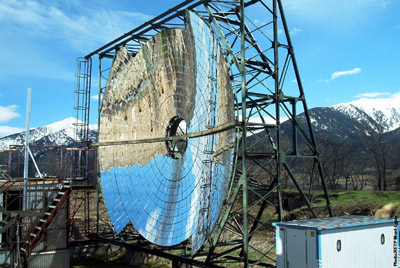 Holy solar furnace, Batman! Holy solar furnace, Batman! |
|
The National Commando Training Center was established at Fort Mont Louis in 1964. Today one of ten such facilities in Europe and Africa, these centers train troops from nations friendly with France in the use of explosives, navigation, militant skiing, climbing and so on. Programs for civilians such as reporters and journalists, who might wish to attempt to survive in a combat situation, are offered as well.
Those not interesting in being shot at can experience Fort Mont Louis' large range of activites and surprises, which include restaurants, shopping, camping and a variety of non-camping accommodations. And the "squirrel cage" well is still there, and semi-operational! I mean I'm not drinking that squirrel water, but you're welcome to give 'er a gulp.
|
|
|
|
|
|
 |




